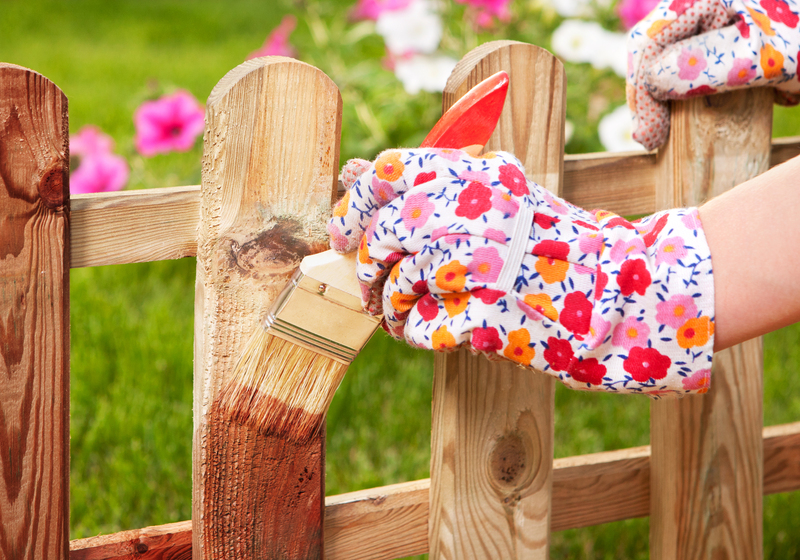Crafting Serenity: Steps to a Stunning and Practical Herb Garden
Posted on 16/09/2025
Crafting Serenity: Steps to a Stunning and Practical Herb Garden
Are you seeking a tranquil escape just outside your back door? Designing a beautiful and functional herb garden is one of the most rewarding ways to bring both serenity and flavor to your life. Whether you have acres of land or a petite balcony, a well-planned herb garden can transform any space into a soothing, sensory retreat. In this comprehensive guide, you'll discover how to craft your own serene sanctuary while ensuring an abundant harvest of aromatic, practical herbs.
Why Create an Herb Garden?
Herb gardens have been cherished for centuries, not only for their culinary delights but also for their contribution to well-being and landscape beauty. Let's delve into the main reasons why starting a stunning and practical herb garden can be life enhancing:
- Aromatic Atmosphere: Fresh herbs release wonderful fragrances, turning your garden into a peaceful oasis.
- Easy Culinary Access: Pluck fresh basil, mint, or rosemary right before cooking - nothing compares to this fresh flavor!
- Visual Appeal: Herbs offer various shades of green, purple, and silver, along with delicate flowers, enhancing your outdoor decor.
- Natural Remedies: Many herbs possess medicinal properties, providing a homegrown remedy chest.
- Wildlife Haven: Pollinators like bees and butterflies are attracted by blooming herb flowers, supporting local biodiversity.
Each of these benefits contributes to the ultimate goal: *crafting serenity* right where you live. By following the steps below, you can establish a practical yet stunning herb garden that suits both novice and seasoned gardeners alike.

Step 1: Choosing the Perfect Location for Your Herb Sanctuary
Every herb garden starts with site selection. Herbs thrive in environments that match their natural preferences, so location is key. Here's how to choose the right place:
Consider Sunlight Needs
- Most culinary herbs such as basil, thyme, oregano, and rosemary require at least 6-8 hours of direct sunlight.
- Partial shade lovers include mint, parsley, and chives, which can tolerate less intense sunlight.
Ensure Good Drainage
- Avoid low-lying areas that tend to collect water. Herbs dislike soggy roots.
- Consider raised beds or large containers with drainage holes if your soil is heavy.
Accessibility and Convenience
The closer your herb patch is to your kitchen or main living area, the more likely you are to use and care for it. An *herb garden* by the back door is ideal!
Step 2: Planning and Designing Your Herb Haven
Design is where creativity meets function. Before breaking ground, consider the following when mapping out your serene herb garden:
- Space: Factor in how much square footage you have - it could be a sprawling bed, a tidy border, or a collection of pots.
- Shape: Formal layouts (symmetrical beds and neat pathways) can evoke a classic, calming appearance. Informal layouts (curving paths and mixed groupings) offer a more relaxed, rustic vibe.
- Focal Points: Installing a birdbath, sundial, or decorative stone in the center can enhance the feeling of tranquility.
Companion Planting: Grouping for Harmony
Some herbs grow best when paired with particular companions. *Strategic planting* not only boosts growth but can also deter pests naturally.
- Basil & Tomatoes: Planting basil near tomatoes improves taste and repels certain insects.
- Rosemary & Sage: These two thrive in dryer soils and lend aromatic structure to the garden's appearance.
- Mints: Grow mint in containers to prevent it from overtaking other herbs.
Step 3: Selecting the Right Herbs for Your Garden
A stunning and practical herb garden features a blend of culinary staples, healing varieties, and ornamentals. Consider your personal preferences and needs when making selections.
Top Culinary Herbs
- Basil: Essential for pesto and salads.
- Thyme: Versatile for meats and vegetables.
- Parsley: Both curly and flat-leaf types are savory and decorative.
- Chives: Mild onion flavor, great in eggs and garnishes.
- Rosemary: Adds aroma and structure to roasts and breads.
- Mint: Refreshing in drinks and desserts.
- Cilantro: Vital for salsas and curries.
Medicinal and Aromatic Herbs
- Lavender: Not only smells divine but is calming in teas and sachets.
- Lemon Balm: Relieves stress and attracts bees.
- Sage: Used in teas for sore throat and as a savory spice
- Chamomile: Classic relaxing herbal tea plant.
Herbs for Pollinators and Beauty
- Borage: Star-shaped blue flowers add color and invite bees.
- Fennel: Feathery foliage and umbrella-like blooms draw butterflies.
Step 4: Preparing the Soil and Planting
Achieving both stunning visuals and practical harvests depends on proper soil preparation and careful planting.
How to Prepare Your Soil
- Check the pH: Most herbs prefer slightly alkaline soil (pH 6.5-7.5).
- Amend with compost: Add well-rotted compost or organic matter to improve drainage, fertility, and structure.
- Remove weeds: Clear the area of competing weeds before planting.
Planting Techniques for Herbs
- Spacing: Allow enough room for each plant's mature size - overcrowding leads to weak plants and poor air circulation.
- Seed vs. Transplant: Some herbs (like dill or coriander) prefer direct seeding, while others (rosemary, thyme) are best started from cuttings or nursery plants.
- Mulching: Apply an organic mulch (like straw or bark chips) around herbs to retain moisture and suppress weeds.
Step 5: Watering, Feeding, and Care
Maintenance is the key to a flourishing, serene herb garden. A few good habits will keep your sanctuary healthy and productive throughout the season.
Watering Wisdom
- Most herbs prefer soil that's consistently moist but never soggy. Overwatering can lead to root rot, especially in pots.
- Drought-tolerant herbs (such as sage, rosemary, and thyme) need less water once established.
- Water in the morning to reduce disease risk and help the plants absorb moisture before the heat of the day.
Feeding Your Herbs
- Less is more: Too much fertilizer can reduce herb flavor and aroma.
- Apply a balanced, organic slow-release fertilizer once or twice per season for best results.
- Compost tea can be used as an occasional boost for container-grown herbs.
Pruning and Harvesting
- Regularly pinch back herbs like basil and mint to encourage bushy, lush growth.
- Harvest early in the day, just after dew has evaporated but before the sun becomes intense, for peak flavor.
- Deadhead flowering herbs (remove spent buds) to prolong the harvest and a tidy look.
Step 6: Enhancing Serenity with Sensory and Visual Elements
The true charm of a serene herb garden lies in its ability to engage all the senses. Here are some creative ways to enhance both beauty and tranquility:
- Colors and Contrasts: Plan your layout to highlight a melange of greens, purple basil, silver sage, and lavender flowers.
- Textures: Combine fine-leaved dill, broad-leaf sage, and glossy basil for tactile interest.
- Sound: Incorporate wind chimes, a small water feature, or ornamental grasses for gentle background noise.
- Seating Areas: Install a bench or stepping stones where you can unwind, read, or meditate amidst the lush herbs.
- Night Lighting: Solar path lights or lanterns invite you to enjoy your peaceful herb garden after sunset.
Step 7: Practical Use of Your Homegrown Herbs
A practical herb garden is one where the harvest is integrated into daily life:
- Culinary: Use fresh herbs to enhance meals, blending flavors into sauces, soups, dressings, and baked goods.
- Herbal Teas & Infusions: Brew soothing teas with mint, chamomile, lemon balm, or lavender straight from your garden.
- Natural Remedies: Homemade tinctures and balms using calendula, sage, and thyme can address minor ailments naturally.
- Crafts & Decor: Create herbal wreaths, sachets, or bath salts using dried herbs for year-round relaxation and gifts.
Preserving Your Bounty: Drying and Storing Herbs
To enjoy your herbs long after the growing season ends, follow these preservation tips:
- Air Drying: Hang small bunches of herbs upside down in a warm, ventilated area away from direct sunlight.
- Freezing: Chop herbs and freeze in ice cube trays covered with olive oil for ready-to-use portions.
- Infusions: Steep fresh herbs in vinegar or oil to create flavorful culinary foundations.

Troubleshooting and Common Mistakes in Herb Gardening
Even the most thoughtfully designed serenity herb gardens encounter challenges. Stay ahead with these preventative tips:
- Overcrowding: Avoid planting too tightly. Good air flow prevents disease.
- Poor Drainage: Signs include yellowing leaves and wilting. Amend soil or use raised beds.
- Pests: Aphids, spider mites, and slugs can be managed with organic sprays or beneficial insects like ladybugs.
- Bolting: Many annual herbs (cilantro, basil) "bolt" and flower if stressed by heat. Provide shade in the hottest hours and harvest frequently.
Embracing Serenity: Your Herbal Oasis Awaits
*Crafting serenity in your outdoor (or indoor!) space begins with the thoughtful creation of a stunning and practical herb garden.* The process--choosing a site, designing with intention, selecting the perfect herbs, and tending them with care--leads not just to a harvest of flavorful leaves, but to a deeper connection with nature and moments of peaceful reflection.
Every time you brush against fragrant leaves, savor a fresh-picked sprig in your favorite dish, or gaze out over your thriving garden, you'll be reminded of the harmony your herbal sanctuary brings to daily life. Whether you're a gardening novice or a seasoned green thumb, you now have the knowledge to design an inviting, lush, and useful retreat.
So roll up your sleeves, grab some seeds or cuttings, and embark on this rewarding, calming journey. Your stunning and practical herb garden is the gateway to everyday serenity!



